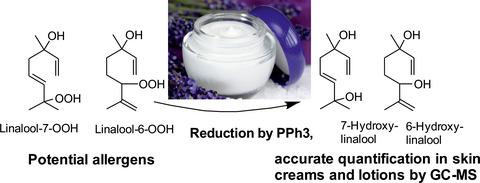当前位置:
X-MOL 学术
›
Flavour Frag. J.
›
论文详情
Our official English website, www.x-mol.net, welcomes your
feedback! (Note: you will need to create a separate account there.)
Interlaboratory evaluation of methods to quantify skin‐sensitizing hydroperoxides of limonene and linalool (II): Analysis in cosmetic bases
Flavour and Fragrance Journal ( IF 2.1 ) Pub Date : 2018-04-22 , DOI: 10.1002/ffj.3451 Andreas Natsch 1 , Susanne Kern 1 , Elise Corbi 2 , Christophe Pérès 2 , Marco Nägelin 3 , Hans Leijs 4 , Michel van Strien 4 , Michael J. Calandra 5 , Ying Wang 5
Flavour and Fragrance Journal ( IF 2.1 ) Pub Date : 2018-04-22 , DOI: 10.1002/ffj.3451 Andreas Natsch 1 , Susanne Kern 1 , Elise Corbi 2 , Christophe Pérès 2 , Marco Nägelin 3 , Hans Leijs 4 , Michel van Strien 4 , Michael J. Calandra 5 , Ying Wang 5
Affiliation

|
The fragrant terpenes limonene and linalool can form skin‐sensitizing hydroperoxides (HPs) upon prolonged exposure to air. Sources of exposure of consumers to sensitizing doses of HPs have not been identified, and it is not clear whether fragranced products are a relevant source. Previously this question was addressed via analytical studies on fine fragrances; however, linalool and limonene are widely used in different consumer products, especially in other leave‐on toiletries. Hence, analytical methods also need to be able to detect potential HPs in more complex consumer product matrices. Here we applied different simple extraction methods and a toolbox of analytical methods to creams and lotions. Blinded samples of a commercial skin cream and a body lotion were spiked with four different HPs at different doses. Five laboratories analysed the samples with a method based on HP reduction in the sample, followed by Extrelut® NT extraction and GC‐MS to quantify the formed alcohols. This method found an average recovery of spiked levels of 80–105%, with a relative standard deviation between laboratories of 11–25% in samples spiked with 100–200 μg g−1. Quantification was also possible in samples spiked with 20–50 μg mL−1, with a relative standard deviation between laboratories of 11–38%. Thus, this method can indirectly detect low levels of HPs in complex bases. In parallel, the same samples were analysed with three LC‐based methods directly detecting the parent HPs: LC coupled with chemiluminescence, LC‐Q‐TOF‐MS, and LC‐orbitrap‐MS. On average, the different analytes were detected with a recovery of 80–143%. No HPs were detected in the non‐spiked products, despite the fact that they do contain linalool and limonene. Results of these studies indicate that consumer exposure can now be studied routinely in different product types as the required methods are ready for roll‐out.
中文翻译:

实验室间评估柠檬烯和芳樟醇对皮肤敏感的氢过氧化物的定量方法(II):化妆品基质中的分析
长时间暴露在空气中,芳香的萜烯柠檬烯和芳樟醇会形成对皮肤敏感的氢过氧化物(HPs)。尚未确定消费者接触致敏剂量的HP的来源,也不清楚加香产品是否是相关来源。以前,这个问题是通过对精美香水的分析研究来解决的。但是,芳樟醇和柠檬烯被广泛用于不同的消费产品,尤其是在其他免洗洗护用品中。因此,分析方法还需要能够检测更复杂的消费产品矩阵中的潜在HP。在这里,我们将不同的简单提取方法和分析方法的工具箱应用于霜剂和洗剂。将市售护肤霜和润肤露的盲样品掺入四种不同剂量的不同HP。®NT萃取和GC-MS对形成的醇进行定量。该方法发现加标水平为100–200μgg -1的样品中加标水平的平均回收率为80–105%,实验室之间的相对标准偏差为11–25%。加标20–50μgmL -1的样品也可以进行定量,实验室之间的相对标准偏差为11–38%。因此,该方法可以间接检测复杂碱基中低水平的HP。同时,使用三种基于LC的方法直接检测母体HP来分析相同的样品:LC结合化学发光,LC-Q-TOF-MS和LC-orbitrap-MS。平均而言,检测到的不同分析物的回收率为80–143%。尽管非加标产品中确实含有芳樟醇和柠檬烯,但未检测到任何HP。这些研究的结果表明,由于可以采用所需的方法,因此现在可以常规地研究不同产品类型的消费者暴露情况。
更新日期:2018-04-22
中文翻译:

实验室间评估柠檬烯和芳樟醇对皮肤敏感的氢过氧化物的定量方法(II):化妆品基质中的分析
长时间暴露在空气中,芳香的萜烯柠檬烯和芳樟醇会形成对皮肤敏感的氢过氧化物(HPs)。尚未确定消费者接触致敏剂量的HP的来源,也不清楚加香产品是否是相关来源。以前,这个问题是通过对精美香水的分析研究来解决的。但是,芳樟醇和柠檬烯被广泛用于不同的消费产品,尤其是在其他免洗洗护用品中。因此,分析方法还需要能够检测更复杂的消费产品矩阵中的潜在HP。在这里,我们将不同的简单提取方法和分析方法的工具箱应用于霜剂和洗剂。将市售护肤霜和润肤露的盲样品掺入四种不同剂量的不同HP。®NT萃取和GC-MS对形成的醇进行定量。该方法发现加标水平为100–200μgg -1的样品中加标水平的平均回收率为80–105%,实验室之间的相对标准偏差为11–25%。加标20–50μgmL -1的样品也可以进行定量,实验室之间的相对标准偏差为11–38%。因此,该方法可以间接检测复杂碱基中低水平的HP。同时,使用三种基于LC的方法直接检测母体HP来分析相同的样品:LC结合化学发光,LC-Q-TOF-MS和LC-orbitrap-MS。平均而言,检测到的不同分析物的回收率为80–143%。尽管非加标产品中确实含有芳樟醇和柠檬烯,但未检测到任何HP。这些研究的结果表明,由于可以采用所需的方法,因此现在可以常规地研究不同产品类型的消费者暴露情况。











































 京公网安备 11010802027423号
京公网安备 11010802027423号